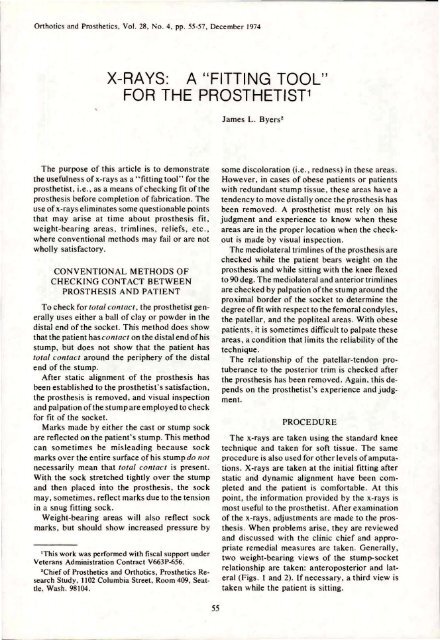Orthotics and Prosthetics
Orthotics and Prosthetics
Orthotics and Prosthetics
Create successful ePaper yourself
Turn your PDF publications into a flip-book with our unique Google optimized e-Paper software.
X-RAYS: A "FITTING TOOL"<br />
FOR THE PROSTHETIST 1<br />
James L. Byers 2<br />
The purpose of this article is to demonstrate<br />
the usefulness of x-rays as a "fitting tool" for the<br />
prosthetist, i.e., as a means of checking fit of the<br />
prosthesis before completion of fabrication. The<br />
use of x-rays eliminates some questionable points<br />
that may arise at time about prosthesis fit,<br />
weight-bearing areas, trimlines, reliefs, etc.,<br />
where conventional methods may fail or are not<br />
wholly satisfactory.<br />
CONVENTIONAL METHODS OF<br />
CHECKING CONTACT BETWEEN<br />
PROSTHESIS AND PATIENT<br />
To check for total contact, the prosthetist generally<br />
uses either a ball of clay or powder in the<br />
distal end of the socket. This method does show<br />
that the patient has contact on the distal end of his<br />
stump, but does not show that the patient has<br />
total contact around the periphery of the distal<br />
end of the stump.<br />
After static alignment of the prosthesis has<br />
been established to the prosthetist's satisfaction,<br />
the prosthesis is removed, <strong>and</strong> visual inspection<br />
<strong>and</strong> palpation of the stump are employed to check<br />
for fit of the socket.<br />
Marks made by either the cast or stump sock<br />
are reflected on the patient's stump. This method<br />
can sometimes be misleading because sock<br />
marks over the entire surface of his stump do not<br />
necessarily mean that total contact is present.<br />
With the sock stretched tightly over the stump<br />
<strong>and</strong> then placed into the prosthesis, the sock<br />
may, sometimes, reflect marks due to the tension<br />
in a snug fitting sock.<br />
Weight-bearing areas will also reflect sock<br />
marks, but should show increased pressure by<br />
1This work was performed with fiscal support under<br />
Veterans Administration Contract V663P-656.<br />
2<br />
Chief of <strong>Prosthetics</strong> <strong>and</strong> <strong>Orthotics</strong>, <strong>Prosthetics</strong> Research<br />
Study, 1102 Columbia Street, Room 409, Seattle,<br />
Wash. 98104.<br />
some discoloration (i.e., redness) in these areas.<br />
However, in cases of obese patients or patients<br />
with redundant stump tissue, these areas have a<br />
tendency to move distally once the prosthesis has<br />
been removed. A prosthetist must rely on his<br />
judgment <strong>and</strong> experience to know when these<br />
areas are in the proper location when the checkout<br />
is made by visual inspection.<br />
The mediolateral trimlines of the prosthesis are<br />
checked while the patient bears weight on the<br />
prosthesis <strong>and</strong> while sitting with the knee flexed<br />
to 90 deg. The mediolateral <strong>and</strong> anterior trimlines<br />
are checked by palpation of the stump around the<br />
proximal border of the socket to determine the<br />
degree of fit with respect to the femoral condyles,<br />
the patellar, <strong>and</strong> the popliteal areas. With obese<br />
patients, it is sometimes difficult to palpate these<br />
areas, a condition that limits the reliability of the<br />
technique.<br />
The relationship of the patellar-tendon protuberance<br />
to the posterior trim is checked after<br />
the prosthesis has been removed. Again, this depends<br />
on the prosthetist's experience <strong>and</strong> judgment.<br />
PROCEDURE<br />
The x-rays are taken using the st<strong>and</strong>ard knee<br />
technique <strong>and</strong> taken for soft tissue. The same<br />
procedure is also used for other levels of amputations.<br />
X-rays are taken at the initial fitting after<br />
static <strong>and</strong> dynamic alignment have been completed<br />
<strong>and</strong> the patient is comfortable. At this<br />
point, the information provided by the x-rays is<br />
most useful to the prosthetist. After examination<br />
of the x-rays, adjustments are made to the prosthesis.<br />
When problems arise, they are reviewed<br />
<strong>and</strong> discussed with the clinic chief <strong>and</strong> appropriate<br />
remedial measures are taken. Generally,<br />
two weight-bearing views of the stump-socket<br />
relationship are taken: anteroposterior <strong>and</strong> lateral<br />
(Figs. 1 <strong>and</strong> 2). If necessary, a third view is<br />
taken while the patient is sitting.
















